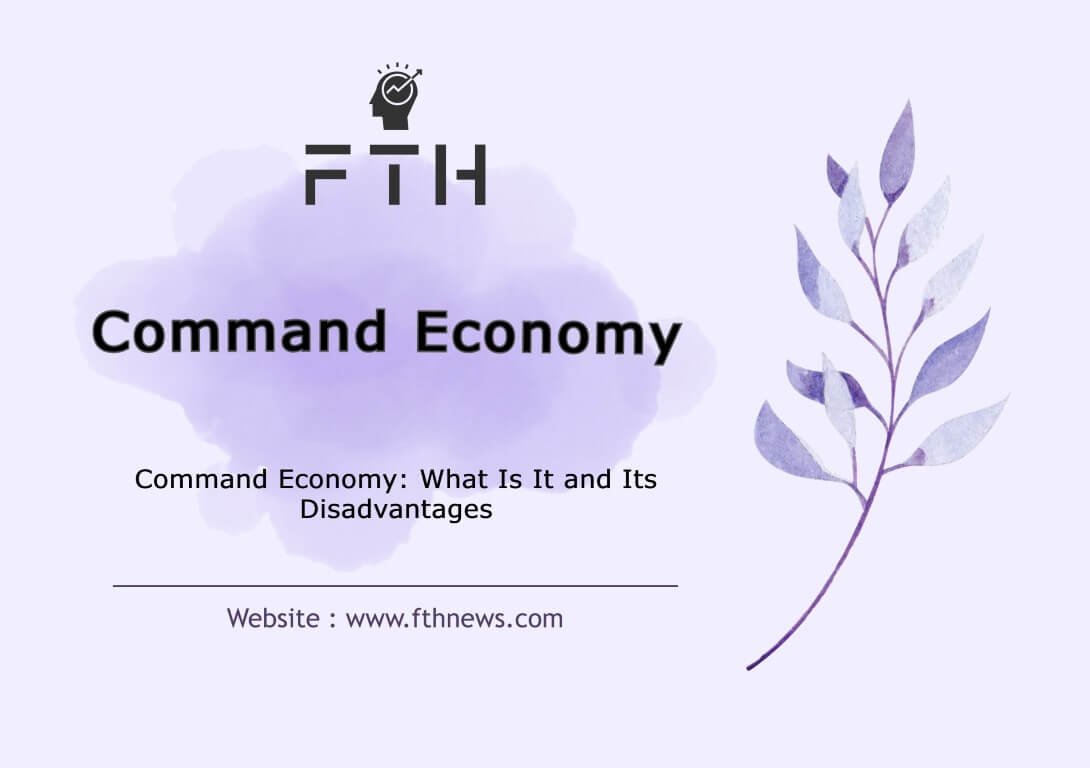
Command Economy: What Is It and Its Disadvantages
A command economy is a distinctive economic system in which the government, rather than the free market, plays a central role in determining what products should be produced and at what prices. Furthermore, it exercises control over investment strategies and income distribution. Command economies are typically associated with communist nations. Clear examples of countries that have adopted command economies include Cuba, North Korea, and the former Soviet Union. It’s worth noting that while China adhered to a command economy for several decades, it eventually transitioned into a mixed economy, incorporating both communist and capitalist elements.
Exploring the Concept of a Command Economy
In a command economy, also known as a planned economy, the primary responsibility for economic planning rests with the government. This governmental body possesses the means of production or closely monitors the production processes at the community level. In such an economic system, private ownership of land, labor, and capital is either nonexistent or severely restricted to support the central government’s economic objectives.
Unlike a free-market economy, where prices of goods and services are determined by supply and demand, in a command economy, the government takes on the responsibility of setting prices and closely monitoring and controlling production. In some cases, this system may even entail restrictions or outright prohibitions on competition within the private sector. In a fully command economy, competition is generally absent because the central government holds a monopoly on economic activities and trade.
Characteristics of a Command Economy
Government Control: In a command economy, the government exercises substantial control over economic activities. It formulates a focused economic plan, typically spanning five years, in which it prioritizes the nation’s social and economic goals. This plan considers various factors such as sectors and regions, with an annual budget to oversee its execution. The government also has the authority to adjust policies as needed to achieve the specified objectives.
Budget and Resource Allocation: Following the establishment of five-year goals, the government crafts policies and allocates resources across different sectors. It closely monitors progress and utilization of natural resources and capital, aligning them with the goals and plans of each sector. Additionally, the government often plays a role in reducing unemployment through strategic resource allocation.
Prioritization: The government, based on prevailing conditions, devises a comprehensive plan for the production, processes, pricing, and quantities of goods and services produced within the country. For instance, national priorities, like ensuring access to food, clothing, and shelter for all, can be set by the government. Subsequently, it allocates the necessary resources and designs programs to work towards these objectives.
Absence of Competition: In a command economy, where the government controls nearly all aspects of economic activity, there is limited room for private companies to compete. Major sectors, including finance, automobiles, information technology, and utilities, are often under government control.
Centralized Authority: The government holds the sole authority for making critical decisions in such an economic system. It formulates policies, enacts laws and regulations, sets targets, prices, and production quantities within a centralized economic program. As a result, even in the presence of a private sector, all companies are bound by the rules and regulations established by the government and cannot operate freely according to their own discretion.
Understanding Command Economy
Command economies, with power centralized within government planners and minimal or no free market mechanisms to regulate prices and coordinate economic activities, face two significant challenges in efficient economic planning: the motivational problem and the economic calculation or knowledge problem.
The motivational problem encompasses several practical aspects. Firstly, government planners and policymakers within a command economy exhibit individual and human characteristics. Economists, inspired by public choice theory and led by figures like James Buchanan, have outlined various ways in which self-interested decision-making by government officials can lead to social costs and substantial losses detrimental to the national interest. In these systems, political interest groups engaged in power struggles over resources often dominate policy-making, as they are not constrained by factors like sovereign credit ratings or capital flight. Consequently, these detrimental effects can be exacerbated.
Incentive issues in a command economy extend beyond government planners and decision-makers. Given that salaries and wages are determined by the government and profits are largely or entirely sacrificed in favor of economic decisions, managers and employees of state-owned enterprises have minimal incentives to enhance work efficiency, control costs, or strive to avoid official penalties, as their positions within the planned hierarchy are secure.
Essentially, in a command economy, the focus shifts from maximizing shareholder value or meeting consumer demands to appeasing partisan and factional leaders and maintaining favorable relationships, leading to a pervasive issue of corruption.
Problems of Economic Calculation
The challenge of economic calculation in a command economy was first elucidated by Austrian economists Ludwig von Mises and F.A. Hayek. Central economic planners must grapple with determining the quantity of each good or service required in the economy, who should produce it, where and when it should be made available, and which technologies, methods, and specific combinations of production factors (land, labor, and capital) should be employed.
Free markets address this problem through decentralized mechanisms involving the interaction of supply and demand based on consumer preferences and the relative scarcity of goods and production factors. In a command economy, the absence of secure property rights and the absence of a free exchange of economic goods and production factors hinder the implementation of supply and demand. Central planners lack a rational means to align the production and distribution of goods and production factors with consumer preferences and genuine resource scarcity. Consequently, shortages and surpluses in consumer goods and production resources, throughout the supply chain, become characteristic issues of this system.
Examples of Command Economies
Soviet Union: The Soviet Union, spanning from 1930 to 1991, operated as a prime example of a command economy. During this period, the government made all significant decisions that shaped the entire country’s economic landscape.
China: After World War II, China adopted a communist system in which the government developed plans for economic growth. While China has transitioned to mixed economies in recent years, it continues to employ five-year plans for economic growth and development.
Cuba: Since the 1959 revolution, Cuba has operated under a command economy and is gradually transitioning toward a mixed economy to foster economic growth.
Dictatorships: Certain countries, under the control of a single authoritarian leader, also adopt command economies. Governments in these nations heavily regulate various business sectors. Examples include Middle Eastern countries like Egypt, Iran, and Libya.
Advantages of a Command Economic System
Resource Mobilization: The government’s complete control enables swift decisions regarding resource allocation, facilitating large-scale projects and adjustments to achieve economic and social objectives.
Uninterruptibility: Government control ensures that decisions and projects are not hindered by individual complaints or opposition, allowing for efficient implementation.
Unified Vision: The system operates according to the government’s singular vision, ensuring that the entire economy works toward common social and economic goals, potentially leading to better outcomes.
Direct Resource Management: Through five-year plans and annual budgets, the government manages resource allocation directly, contributing to economic growth.
Disadvantages of a Command Economic System
Government Control: In a command economy, all decisions are made by the government, leaving limited room for individual or market-driven choices. This can sometimes result in inefficiencies and a lack of adaptability.
Shadow Economy/Black Market: When the government fails to meet the needs of the people, a shadow economy or black market may emerge, providing goods and services not provided by the government but at higher prices. This can foster illegal wealth and undermine the formal economic and social system.
Lack of Market Understanding: Governments in command economies may struggle to grasp evolving market demands, making it challenging to align with consumer needs and price structures.
Inhibition of Competition and Innovation: The absence of competition and innovation can hinder economic progress, especially in the face of a global market that thrives on innovation, competition, and technological adaptation. Meeting consumer demands, both domestically and globally, remains a significant challenge in such economies.
Arguments of Command Economy Advocates
Command economies have their proponents, and they put forward several arguments in favor of this economic system.
- Maximizing Social Welfare Over Profits
Supporters of command economies contend that the primary objective of this system is to allocate resources in a way that maximizes social welfare. In contrast, they argue that in free-market economies, profit maximization takes precedence, and the pursuit of social welfare is often secondary. This prioritization, according to advocates of command economies, can lead to more equitable resource distribution.
- Employment Control
Another argument in favor of command economies is their perceived ability to exert greater control over employment levels compared to free-market economies. In a command economy, the government can create jobs when necessary, even if there is no immediate legal or market-driven demand for such positions. Advocates argue that this flexibility can help maintain stable employment, reducing the risk of widespread unemployment during economic downturns.
- Crisis Management and Coordination
Proponents of command economies assert that these systems demonstrate higher levels of determination and coordination when faced with national crises, such as wars and natural disasters. Even in many governments and societies with predominantly free-market economies, there tends to be an inclination to temporarily restrict property rights and expand centralized power during crises. Advocates argue that command economies are better equipped to respond swiftly and effectively to such challenges, potentially minimizing the impact on the population.
Command Economy vs. Free Market Economy
Free Market Economy: In a free market economy, prices of goods and services are determined by supply and demand. Individual firms have the freedom to set prices, hire and fire workers, and produce what they find profitable.
Command Economy: In a command economy, the government makes all economic decisions. It sets prices, determines production, and allocates resources. Command economies are also known as planned economies.
Economic Efficiency Debate: Economists have differing opinions on which system is more efficient. Some argue that command economies can be more agile during crises but may be less efficient and prone to stagnation. Both systems have advantages and disadvantages.
Mixed Economies: Many countries have mixed economies that blend elements of both command and free market systems to varying degrees.
Political Influence: Command economies are often found in countries with authoritarian governments, while free market economies are more common in democracies.
This summary highlights the key differences and considerations between these two economic systems.
In conclusion
a command economy operates with centralized control, bypassing the role of demand and supply in determining the production, processes, quantities, and prices of goods and services within a country. This approach hinders competition and innovation, critical components in today’s global economy.
While the government’s focus on resource allocation aims to achieve economic and social well-being, many command economies have struggled to attain this objective. Nevertheless, there are certain advantages to a command economy, as it allows swift decision-making in response to market demands to fulfill economic goals.
In recent times, especially following the collapse of the Soviet Union in 1991, most of the world’s economies have adopted elements of capitalism, resulting in the emergence of mixed economies that encourage competition and innovation. However, some goods and services continue to be under government control, while the majority of sectors now adhere to supply and demand dynamics.
This shift toward mixed economies reflects a modern economic landscape where a blend of market-driven and government-controlled elements coexist.
FAQ
A command economy is an economic system where the government makes all major decisions about what, how, and for whom to produce goods and services. An example of a command economy is the former Soviet Union, where the government controlled all economic activities, from production to distribution.
A command economy is when the government controls what, how, and for whom goods and services are produced.














